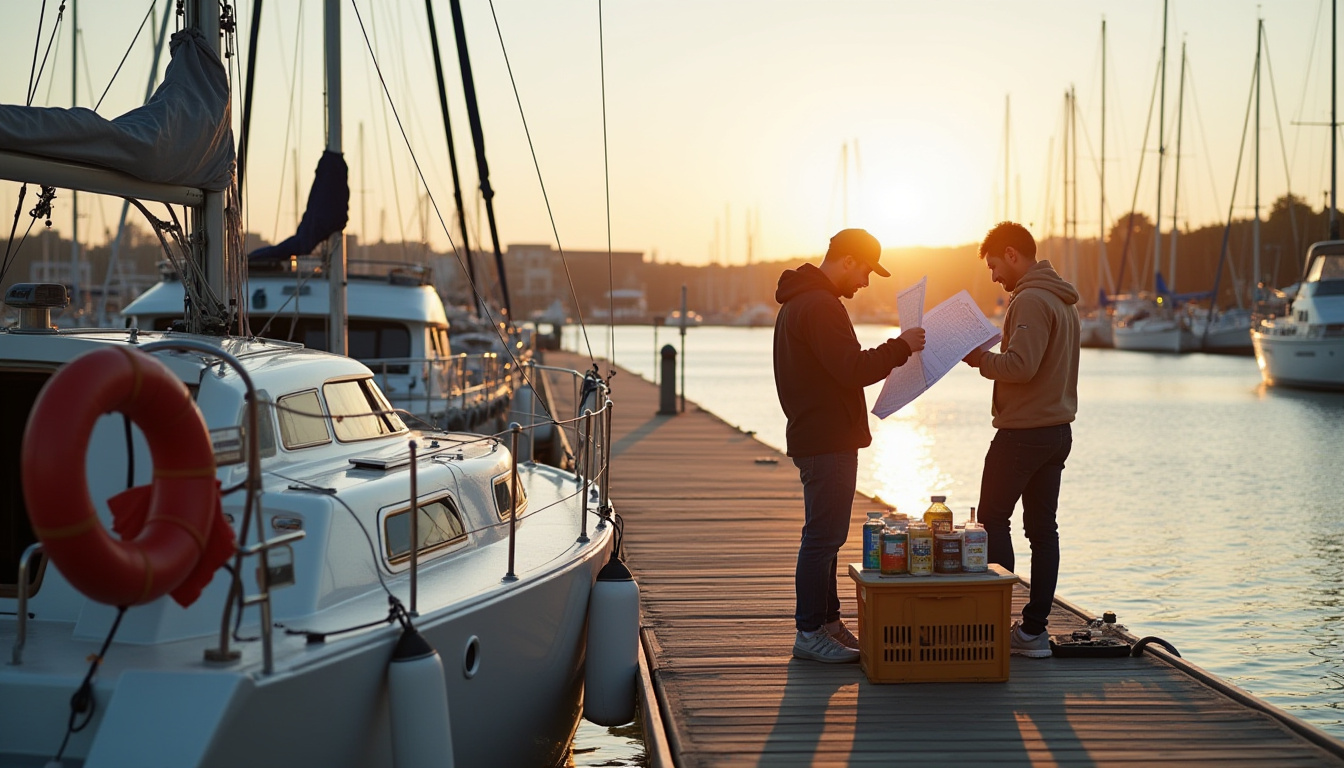Embarking on a long sailing trip is a dream for many—a chance to disconnect, embrace the rhythm of the sea, and explore distant horizons. Whether you’re planning a multi-week journey across the Atlantic or a months-long voyage through the Caribbean, preparation is key to ensuring a safe and enjoyable adventure. This guide offers practical tips and advice, from provisioning to safety checks, to help you navigate the challenges and joys of extended time on the water.
Why Preparation Matters for a Long Sailing Trip
A long sailing trip isn’t a spontaneous getaway; it requires meticulous planning to handle the unpredictability of the ocean. For starters, you’ll be far from shore, where resources are scarce and help may be days away. Moreover, the sea can be both a friend and a foe—calm one day, stormy the next. Consequently, thorough preparation minimizes risks and maximizes enjoyment, letting you focus on the journey rather than the obstacles.
The Rewards of a Well-Planned Journey
Proper planning transforms challenges into opportunities. For instance, stocking the right supplies means you can enjoy fresh meals even after weeks at sea. Additionally, a well-maintained boat ensures you’re ready for rough weather. This groundwork sets the stage for a trip filled with stunning sunsets, starlit nights, and the thrill of discovery.
Step 1: Plan Your Route for a Long Sailing Trip
Your route is the backbone of your journey. Start by choosing a destination that matches your experience level—beginners might opt for a coastal route with frequent ports, while seasoned sailors could tackle an ocean crossing. Next, study charts and weather patterns; apps like Windy or PredictWind offer real-time forecasts. Also, identify stopover points for resupplying or repairs. For example, sailing from Florida to the Bahamas, you might plan stops in Bimini and Nassau.
Timing Your Departure
Timing is critical. For instance, crossing the Atlantic is safest between November and February to avoid hurricane season. Meanwhile, the Mediterranean is best in summer for calm seas. Transitioning from planning to execution requires flexibility—be ready to adjust your departure if a storm brews.
Step 2: Inspect and Maintain Your Boat
A seaworthy vessel is non-negotiable for a long sailing trip. Begin with a thorough inspection: check the hull for cracks, test the engine, and inspect sails for tears. Next, service all systems—electrical, plumbing, and navigation. For example, ensure your GPS and VHF radio are functioning, as they’re your lifelines in an emergency. Also, replace worn parts like ropes or filters to prevent mid-sea failures.
Safety Equipment Checklist
Stock essential safety gear: life jackets, a life raft, EPIRB (Emergency Position Indicating Radio Beacon), and flares. Additionally, carry a first-aid kit with seasickness remedies and antibiotics. For instance, a well-stocked kit can handle minor injuries when you’re days from a doctor. Transitioning from maintenance to safety prep ensures your boat is ready for any scenario.
Step 3: Provisioning for a Long Sailing Trip
Food and water are your fuel, so plan carefully. Calculate daily needs—about 2 liters of water per person, plus 2,000 calories of food. For a 30-day trip with four people, that’s 240 liters of water and 240,000 calories. Stock non-perishables like rice, beans, and canned goods, but include morale-boosters like chocolate or coffee. Also, bring a watermaker or extra tanks, as refilling mid-ocean isn’t an option.
Meal Planning and Storage
Plan simple, one-pot meals to save on cooking fuel—think stews or pasta dishes. Vacuum-seal perishables like meat to extend shelf life, and store food in airtight containers to keep out moisture. For example, a small fridge can hold fresh produce for the first week, while canned veggies cover the rest. Transitioning from provisioning to cooking strategy keeps meals manageable on a rocking boat.
Step 4: Pack Smart for a Long Sailing Trip
Packing for a long sailing trip means balancing necessity with space. Start with clothing: pack layers for varying weather—quick-dry shirts, fleece jackets, and waterproof gear. Also, include non-slip shoes and gloves for handling ropes. Next, bring personal items like toiletries, but opt for biodegradable products to minimize environmental impact. Finally, pack entertainment—books, cards, or a downloaded playlist—since internet access will be spotty.
Gear for Comfort and Safety
Don’t forget comfort items like a good sleeping bag for chilly nights or a hammock for lounging on deck. For safety, pack a headlamp with extra batteries and a multi-tool for quick fixes. For instance, a headlamp is invaluable during a nighttime sail. Transitioning from essentials to extras ensures you’re prepared without overloading the boat.
Step 5: Build Skills for a Long Sailing Trip
Even experienced sailors can benefit from brushing up on skills. First, practice navigation—know how to use a sextant and paper charts in case electronics fail. Next, take a first-aid course; you might need to handle a broken bone or severe seasickness far from help. Also, learn basic repairs—patching a sail or fixing a pump can save your trip. For example, a small leak in the bilge pump can become a crisis if you’re unprepared.
Crew Dynamics and Roles
If sailing with others, assign roles: one person handles navigation, another cooking, and so on. Practice teamwork drills, like man-overboard scenarios, to build trust. For instance, a well-coordinated crew can retrieve a fallen sailor in under a minute. Transitioning from individual skills to team prep ensures everyone’s ready to contribute.

Step 6: Plan for Emergencies on a Long Sailing Trip
The ocean is unpredictable, so emergency planning is crucial. First, create a float plan—share your route, expected return date, and emergency contacts with a trusted friend. Next, carry communication devices: a satellite phone or SSB radio for long-range contact. Also, pack a ditch bag with essentials—water, food, flares—if you need to abandon ship. For example, an EPIRB can signal your location to rescuers within hours.
Weather and Health Preparedness
Monitor weather daily via radio or satellite updates, and know how to read signs like a sudden drop in barometric pressure. For health, stock medications for chronic conditions, plus extras for seasickness or infections. Transitioning from planning to vigilance keeps you ahead of potential crises.
The Cost of a Long Sailing Trip
Costs depend on your boat, route, and duration. If you own a boat, budget for maintenance—$2,000 for pre-trip checks—and provisions, around $1,500 for a month for four people. Chartering a yacht for a month might start at $5,000, plus fuel and mooring fees, adding $2,000. Also, factor in insurance or emergency funds—$1,000 as a buffer. For this reason, planning your budget early avoids financial stress.
Saving on Expenses
Save by cooking your own meals instead of eating at ports, and choose free anchorages over marinas when possible. For example, anchoring off a remote beach in the Bahamas costs nothing compared to a $100 marina fee. Transitioning from cost to savings strategies keeps your trip affordable.
Challenges of a Long Sailing Trip
Extended time at sea brings unique challenges. Isolation can strain mental health—days without land can feel endless, so plan activities to stay engaged. Additionally, weather can turn quickly; a storm might force you to hunker down for days. Equipment failures, like a broken rudder, can also test your resilience. Nevertheless, preparation turns these hurdles into manageable bumps.
障害を乗り越える
Combat isolation with a routine—daily tasks like journaling or fishing give structure. For weather, have a storm plan: secure loose items and know your boat’s limits. For repairs, carry a spares kit—extra hoses, belts, and tools. Transitioning from challenge to solution keeps morale high.
Why Embark on a Long Sailing Trip?
A long sailing trip offers rewards few vacations can match. It’s a chance to disconnect from digital noise and reconnect with nature—think dolphins swimming alongside or a meteor shower at midnight. Furthermore, it builds resilience and skills, from navigation to problem-solving. For families or couples, it’s a bonding experience, sharing the highs and lows of the journey.
A Journey of Self-Discovery
The sea strips life to its essentials, teaching patience and humility. For instance, waiting out a storm in a remote anchorage forces you to slow down and reflect. This introspection, paired with the adventure, makes a long sailing trip a transformative experience.
Final Thoughts on Preparing for a Long Sailing Trip
A long sailing trip is a test of preparation, skill, and spirit, but the rewards—unforgettable vistas, newfound confidence, and stories for a lifetime—are worth every effort. From provisioning to safety checks, each step ensures you’re ready for the sea’s challenges and gifts. So, chart your course, pack your bags, and set sail—the ocean’s waiting to share its secrets.

 長期セーリング旅行の準備:ヒントとアドバイス">
長期セーリング旅行の準備:ヒントとアドバイス">
